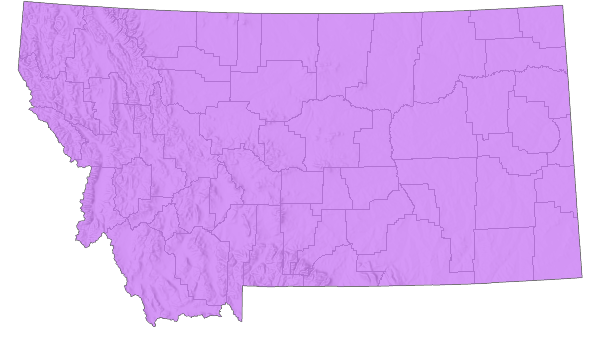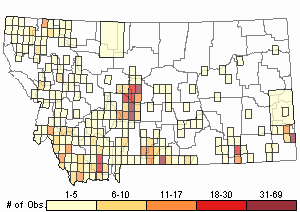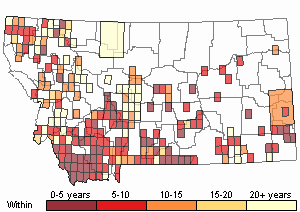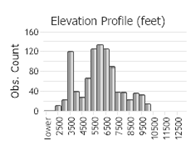View in other NatureServe Network Field Guides
NatureServe
Montana
Utah
Wyoming
Idaho
Wisconsin
British Columbia
South Carolina
Yukon
California
New York
Silvery Lupine - Lupinus argenteus
Native Species
Global Rank:
G5
State Rank:
S5
C-value:
3
Agency Status
USFWS:
USFS:
BLM:
External Links
General Description
Perennial from a shallow, branched caudex. Stems erect to ascending, 10–90 cm, simple or branched above, glabrate to sericeous. Leaves mostly cauline; lower petioles 2–15 cm long; leaflets 5 to 11, strigose to sericeous, sometimes glabrate above, 2–7 cm long with acute tips. Racemes moderately dense, greater than the leaves, 2–15 cm long. Flowers blue; calyx tube 1–3 mm long, flush with the pedicel or distended into a spur <1 mm long; upper lip 1–4 mm long; lower lip slightly longer; banner 4–11 mm long, glabrous or nearly so, reflexed <45°; wings 5–13 mm long. Legume 8–25 mm long (
Lesica et al. 2012. Manual of Montana Vascular Plants. BRIT Press. Fort Worth, TX).
The five varieties occuring in Montana are:
argenteus,
argentatus (Rydb.) Barneby,
depressus (Rydb.) C.L. Hitchc.,
parviflorus (Nutt. ex Hook. & Arn.) C.L. Hitchc., and
rubricaulis (Greene) S.L. Welsh.
Species Range
Montana Range
Range Descriptions

 Native
Native
Range Comments
BC to SK south to CA, AZ, NM and OK (Lesica et al. 2012. Manual of Montana Vascular Plants. BRIT Press. Fort Worth, TX).
Observations in Montana Natural Heritage Program Database
Number of Observations: 1170
(Click on the following maps and charts to see full sized version)
Map Help and Descriptions
Relative Density

Recency



 (Observations spanning multiple months or years are excluded from time charts)
(Observations spanning multiple months or years are excluded from time charts)
Habitat
Grasslands, sagebrush steppe, open forest, woodlands, fellfields; plains, valleys to alpine (
Lesica et al. 2012. Manual of Montana Vascular Plants. BRIT Press. Fort Worth, TX).
National Vegetation Classification System Groups Associated with this Species
Ecology
POLLINATORS The following animal species have been reported as pollinators of this plant species or its genus where their geographic ranges overlap:
Bombus vagans,
Bombus bifarius,
Bombus centralis,
Bombus fervidus,
Bombus flavifrons,
Bombus frigidus,
Bombus huntii,
Bombus melanopygus,
Bombus mixtus,
Bombus nevadensis,
Bombus rufocinctus,
Bombus sylvicola,
Bombus sitkensis,
Bombus occidentalis,
Bombus pensylvanicus,
Bombus bimaculatus,
Bombus griseocollis,
Bombus impatiens, and
Bombus kirbiellus (Macior 1974, Thorp et al. 1983, Bauer 1983, Mayer et al. 2000, Wilson et al. 2010, Colla and Dumesh 2010, Koch et al. 2012, Miller-Struttmann and Galen 2014, Williams et al. 2014).
Stewardship Responsibility
References
- Literature Cited AboveLegend:
 View Online Publication
View Online Publication Bauer, P.J. 1983. Bumblebee pollination relationships on the Beartooth Plateau tundra of Southern Montana. American Journal of Botany. 70(1): 134-144.
Bauer, P.J. 1983. Bumblebee pollination relationships on the Beartooth Plateau tundra of Southern Montana. American Journal of Botany. 70(1): 134-144. Colla, S.R. and S. Dumesh. 2010. The bumble bees of southern Ontario: notes on natural history and distribution. Journal of the Entomological Society of Ontario 141:39-68.
Colla, S.R. and S. Dumesh. 2010. The bumble bees of southern Ontario: notes on natural history and distribution. Journal of the Entomological Society of Ontario 141:39-68. Koch, J., J. Strange, and P. Williams. 2012. Bumble bees of the western United States. Washington, DC: USDA Forest Service, Pollinator Partnership. 143 p.
Koch, J., J. Strange, and P. Williams. 2012. Bumble bees of the western United States. Washington, DC: USDA Forest Service, Pollinator Partnership. 143 p. Lesica, P., M.T. Lavin, and P.F. Stickney. 2012. Manual of Montana Vascular Plants. Fort Worth, TX: BRIT Press. viii + 771 p.
Lesica, P., M.T. Lavin, and P.F. Stickney. 2012. Manual of Montana Vascular Plants. Fort Worth, TX: BRIT Press. viii + 771 p. Macior, L.M. 1974. Pollination ecology of the Front Range of the Colorado Rocky Mountains. Melanderia 15: 1-59.
Macior, L.M. 1974. Pollination ecology of the Front Range of the Colorado Rocky Mountains. Melanderia 15: 1-59. Mayer, D.F., E.R. Miliczky, B.F. Finnigan, and C.A. Johnson. 2000. The bee fauna (Hymenoptera: Apoidea) of southeastern Washington. Journal of the Entomological Society of British Columbia 97: 25-31.
Mayer, D.F., E.R. Miliczky, B.F. Finnigan, and C.A. Johnson. 2000. The bee fauna (Hymenoptera: Apoidea) of southeastern Washington. Journal of the Entomological Society of British Columbia 97: 25-31. Miller-Struttmann, N.E. and C. Galen. 2014. High-altitude multi-taskers: bumble bee food plant use broadens along an altitudinal productivity gradient. Oecologia 176:1033-1045.
Miller-Struttmann, N.E. and C. Galen. 2014. High-altitude multi-taskers: bumble bee food plant use broadens along an altitudinal productivity gradient. Oecologia 176:1033-1045. Thorp, R.W., D.S. Horning, and L.L. Dunning. 1983. Bumble bees and cuckoo bumble bees of California (Hymenoptera: Apidae). Bulletin of the California Insect Survey 23:1-79.
Thorp, R.W., D.S. Horning, and L.L. Dunning. 1983. Bumble bees and cuckoo bumble bees of California (Hymenoptera: Apidae). Bulletin of the California Insect Survey 23:1-79. Williams, P., R. Thorp, L. Richardson, and S. Colla. 2014. Bumble Bees of North America. Princeton, NJ: Princeton University Press. 208 p.
Williams, P., R. Thorp, L. Richardson, and S. Colla. 2014. Bumble Bees of North America. Princeton, NJ: Princeton University Press. 208 p. Wilson, J.S., L.E. Wilson, L.D. Loftis, and T. Griswold. 2010. The montane bee fauna of north central Washington, USA, with floral associations. Western North American Naturalist 70(2): 198-207.
Wilson, J.S., L.E. Wilson, L.D. Loftis, and T. Griswold. 2010. The montane bee fauna of north central Washington, USA, with floral associations. Western North American Naturalist 70(2): 198-207.
- Additional ReferencesLegend:
 View Online Publication
View Online Publication
Do you know of a citation we're missing? Aho, Ken Andrew. 2006. Alpine and Cliff Ecosystems in the North-Central Rocky Mountains. Ph.D. Dissertation. Bozeman, Montana: Montana State University. 343 p.
Aho, Ken Andrew. 2006. Alpine and Cliff Ecosystems in the North-Central Rocky Mountains. Ph.D. Dissertation. Bozeman, Montana: Montana State University. 343 p. Ament, R.J. 1995. Pioneer Plant Communities Five Years After the 1988 Yellowstone Fires. M.Sc. Thesis. Bozeman, MT: Montana State University. 216 p.
Ament, R.J. 1995. Pioneer Plant Communities Five Years After the 1988 Yellowstone Fires. M.Sc. Thesis. Bozeman, MT: Montana State University. 216 p. Buchanan, B.A. 1972. Ecological effects of weather modification, Bridger Range area, Montana: relationship of soil, vegetation, and microclimate. Ph.D. Dissertation. Montana State University, Bozeman. 130 p.
Buchanan, B.A. 1972. Ecological effects of weather modification, Bridger Range area, Montana: relationship of soil, vegetation, and microclimate. Ph.D. Dissertation. Montana State University, Bozeman. 130 p. Clark, D. 1991. The effect of fire on Yellowstone ecosystem seed banks. M.Sc. Thesis. Montana State University, Bozeman. 115 pp.
Clark, D. 1991. The effect of fire on Yellowstone ecosystem seed banks. M.Sc. Thesis. Montana State University, Bozeman. 115 pp. DuBois, K.L. 1979. An inventory of the avifauna in the Long Pines of Southeastern Montana. M.Sc. Thesis. Bozeman, MT: Montana State University. 113 p.
DuBois, K.L. 1979. An inventory of the avifauna in the Long Pines of Southeastern Montana. M.Sc. Thesis. Bozeman, MT: Montana State University. 113 p. Durham, R. A., D. L. Mummey, L. Shreading, and P.W. Ramsey. 2017. Phenological patterns differ between exotic and native plants: Field observations from the Sapphire Mountains, Montana. Natural Areas Journal, 37(3), 361–381.
Durham, R. A., D. L. Mummey, L. Shreading, and P.W. Ramsey. 2017. Phenological patterns differ between exotic and native plants: Field observations from the Sapphire Mountains, Montana. Natural Areas Journal, 37(3), 361–381. Eggers, M.J.S. 2005. Riparian vegetation of the Montana Yellowstone and cattle grazing impacts thereon. M.Sc. Thesis. Montana State University, Bozeman, MT. 125 p.
Eggers, M.J.S. 2005. Riparian vegetation of the Montana Yellowstone and cattle grazing impacts thereon. M.Sc. Thesis. Montana State University, Bozeman, MT. 125 p. Forcella, F. 1977. Flora, chorology, biomass and productivity of the Pinus albicaulis-Vaccinium scoparium association. M.S. Thesis. Bozeman, MT: Montana State University. 99 pp.
Forcella, F. 1977. Flora, chorology, biomass and productivity of the Pinus albicaulis-Vaccinium scoparium association. M.S. Thesis. Bozeman, MT: Montana State University. 99 pp. Fultz, J.E. 2005. Effects of shelterwood management on flower-visiting insects and their floral resources. M.Sc. Thesis. Bozeman, MT: Montana State University. 163 p.
Fultz, J.E. 2005. Effects of shelterwood management on flower-visiting insects and their floral resources. M.Sc. Thesis. Bozeman, MT: Montana State University. 163 p. Gobeille, J.E. 1992. The effect of fire on Merriams turkey brood habitat in southeastern Montana. M.Sc. Thesis. Bozeman, MT: Montana State University. 61 p.
Gobeille, J.E. 1992. The effect of fire on Merriams turkey brood habitat in southeastern Montana. M.Sc. Thesis. Bozeman, MT: Montana State University. 61 p. Hodgson, J.R. 1970. Ecological distribution of Microtus montanus and Microtus pennsylvanicus in an area of geographic sympatry in southwestern Montana. Ph.D. Dissertation. Bozeman, Montana: Montana State University. 65 p.
Hodgson, J.R. 1970. Ecological distribution of Microtus montanus and Microtus pennsylvanicus in an area of geographic sympatry in southwestern Montana. Ph.D. Dissertation. Bozeman, Montana: Montana State University. 65 p. Jones, W. W. 1901. Preliminary flora of Gallatin County. M.S. Thesis. Bozeman, MT: Montana State College. 78 pp.
Jones, W. W. 1901. Preliminary flora of Gallatin County. M.S. Thesis. Bozeman, MT: Montana State College. 78 pp. Joslin, G.J. 1975. Behavior and environmental selection by Elk (Cervus canadensis nelsoni) during surrmer and fall in the First and Second Yellow Mule drainages, Madison County, Montana. M.Sc. Thesis. Bozeman, Montana: Montana State University, Bozeman. 65 p.
Joslin, G.J. 1975. Behavior and environmental selection by Elk (Cervus canadensis nelsoni) during surrmer and fall in the First and Second Yellow Mule drainages, Madison County, Montana. M.Sc. Thesis. Bozeman, Montana: Montana State University, Bozeman. 65 p. Larson, C.D., E.A. Lehnhoff, and L.J. Rew. 2017. A warmer and drier climate in the northern sagebrush biome does not promote Cheatgrass invasion or change its response to fire. Oecologia 185:763-774.
Larson, C.D., E.A. Lehnhoff, and L.J. Rew. 2017. A warmer and drier climate in the northern sagebrush biome does not promote Cheatgrass invasion or change its response to fire. Oecologia 185:763-774. Lesica, P., M.T. Lavin, and P.F. Stickney. 2022. Manual of Montana Vascular Plants, Second Edition. Fort Worth, TX: BRIT Press. viii + 779 p.
Lesica, P., M.T. Lavin, and P.F. Stickney. 2022. Manual of Montana Vascular Plants, Second Edition. Fort Worth, TX: BRIT Press. viii + 779 p. Martin, S.A. 1985. Ecology of the Rock Creek bighorn sheep herd, Beartooth Mountains, Montana. M.Sc. Thesis. Bozeman, MT: Montana State University. 152 p.
Martin, S.A. 1985. Ecology of the Rock Creek bighorn sheep herd, Beartooth Mountains, Montana. M.Sc. Thesis. Bozeman, MT: Montana State University. 152 p. Meier, G.A. 1997. The colonization of Montana roadsides by native and exotic plants. M.Sc. Thesis. Bozeman, MT: Montana State University. 45 p.
Meier, G.A. 1997. The colonization of Montana roadsides by native and exotic plants. M.Sc. Thesis. Bozeman, MT: Montana State University. 45 p. Nyberg, H.E. 1980. Distribution, movements and habitat use of mule deer associated with the Brackett Creek winter range, Bridger Mountains, Montana. M.Sc. Thesis. Bozeman, MT: Montana State University. 106 p.
Nyberg, H.E. 1980. Distribution, movements and habitat use of mule deer associated with the Brackett Creek winter range, Bridger Mountains, Montana. M.Sc. Thesis. Bozeman, MT: Montana State University. 106 p. Pallister, G.L. 1974. The seasonal distribution and range use of bighorn sheep in the Beartooth Mountains, with special reference to the West Rosebud and Stillwater herds. M.Sc. Thesis. Bozeman, MT: Montana State University. 67 p.
Pallister, G.L. 1974. The seasonal distribution and range use of bighorn sheep in the Beartooth Mountains, with special reference to the West Rosebud and Stillwater herds. M.Sc. Thesis. Bozeman, MT: Montana State University. 67 p. Parks, J.C. 1986. Plant materials for use on disturbed alpine areas in Montana. M.Sc. Thesis. Bozeman, MT: Montana State University. 57 p.
Parks, J.C. 1986. Plant materials for use on disturbed alpine areas in Montana. M.Sc. Thesis. Bozeman, MT: Montana State University. 57 p. Quire, R.L. 2013. The sagebrush steppe of Montana and southeastern Idaho shows evidence of high native plant diversity, stability, and resistance to the detrimental effects of nonnative plant species. M.Sc. Thesis. Bozeman, MT: Montana State University. 124 p.
Quire, R.L. 2013. The sagebrush steppe of Montana and southeastern Idaho shows evidence of high native plant diversity, stability, and resistance to the detrimental effects of nonnative plant species. M.Sc. Thesis. Bozeman, MT: Montana State University. 124 p. Rosgaard, A.I., Jr. 1981. Ecology of the mule deer associated with the Brackett Creek winter range in the Bridger Mountains, Montana. M.Sc. Thesis. Bozeman, MT: Montana State University. 76 p.
Rosgaard, A.I., Jr. 1981. Ecology of the mule deer associated with the Brackett Creek winter range in the Bridger Mountains, Montana. M.Sc. Thesis. Bozeman, MT: Montana State University. 76 p. Seipel, T., L.J. Rew, K.T. Taylor, B.D. Maxwell, and E.A. Lehnhoff. 2018. Applied Vegetation Science 21:385-394.
Seipel, T., L.J. Rew, K.T. Taylor, B.D. Maxwell, and E.A. Lehnhoff. 2018. Applied Vegetation Science 21:385-394. Seipel, T.F. 2006. Plant species diversity in the sagebrush steppe of Montana. M.Sc. Thesis. Bozeman, MT: Montana State University. 87 p.
Seipel, T.F. 2006. Plant species diversity in the sagebrush steppe of Montana. M.Sc. Thesis. Bozeman, MT: Montana State University. 87 p. Simanonok, M. 2018. Plant-pollinator network assembly after wildfire. Ph.D. Dissertation. Bozeman, MT: Montana State University. 123 p.
Simanonok, M. 2018. Plant-pollinator network assembly after wildfire. Ph.D. Dissertation. Bozeman, MT: Montana State University. 123 p. Simanonok, M.P. and L.A. Burkle. 2019. Nesting success of wood-cavity-nesting bees declines with increasing time since wildfire. Ecology and Evolution 9:12436-12445.
Simanonok, M.P. and L.A. Burkle. 2019. Nesting success of wood-cavity-nesting bees declines with increasing time since wildfire. Ecology and Evolution 9:12436-12445. Stewart, S.T. 1975. Ecology of the West Rosebud and Stillwater bighorn sheep herds, Beartooth Mountains, Montana. M.Sc. Thesis. Bozeman, MT: Montana State University. 130 p.
Stewart, S.T. 1975. Ecology of the West Rosebud and Stillwater bighorn sheep herds, Beartooth Mountains, Montana. M.Sc. Thesis. Bozeman, MT: Montana State University. 130 p. Stoecker, R.E. 1967. A population study of five species of small rodents in the Bridger Mountains of Montana. M.Sc. Thesis. Bozeman, Montana: Montana State University. 32 p.
Stoecker, R.E. 1967. A population study of five species of small rodents in the Bridger Mountains of Montana. M.Sc. Thesis. Bozeman, Montana: Montana State University. 32 p. Thompson, W. L. 1993. Ecology of Merriam's Turkeys in relation to burned and logged areas in southeastern Montana. Ph.D. Dissertation. Bozeman, MT: Montana State University. 195 p.
Thompson, W. L. 1993. Ecology of Merriam's Turkeys in relation to burned and logged areas in southeastern Montana. Ph.D. Dissertation. Bozeman, MT: Montana State University. 195 p. Williams, K.L. 2012. Classification of the grasslands, shrublands, woodlands, forests and alpine vegetation associations of the Custer National Forest portion of the Beartooth Mountains in southcentral Montana. M.Sc. Thesis. Bozeman, MT: Montana State University. 376 p.
Williams, K.L. 2012. Classification of the grasslands, shrublands, woodlands, forests and alpine vegetation associations of the Custer National Forest portion of the Beartooth Mountains in southcentral Montana. M.Sc. Thesis. Bozeman, MT: Montana State University. 376 p. Wiman, N.G. 2001. Dynamics of leafy spurge (Euphorbia esula L.) infested plant communities influenced by flea beetles in the Aphthona complex (Colepotera: Chrysomelidae). M.Sc. Thesis. Bozeman, MT: Montana State University. 148 p.
Wiman, N.G. 2001. Dynamics of leafy spurge (Euphorbia esula L.) infested plant communities influenced by flea beetles in the Aphthona complex (Colepotera: Chrysomelidae). M.Sc. Thesis. Bozeman, MT: Montana State University. 148 p. Wood, M.A. 1981. Small mammal communities after two recent fires in Yellowstone National Park. M.Sc. Thesis. Bozeman, Montana: Montana State University. 58 p.
Wood, M.A. 1981. Small mammal communities after two recent fires in Yellowstone National Park. M.Sc. Thesis. Bozeman, Montana: Montana State University. 58 p.
- Web Search Engines for Articles on "Silvery Lupine"





